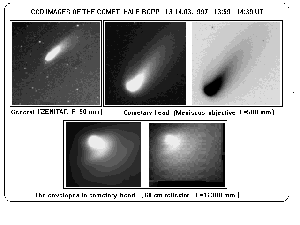Planetary Satellites, Comets, and Asteroids
Among many other observations of solar system bodies, the most interesting observations were of comets, mutual events in the Jupiter and Saturn satellite systems, and the rotation of the asteroid Vesta. The first experiments in the observations of mutual occultations and eclipses of the Galilean satellites were in 1985. Although the target of these observations was astrometric in order to specify the satellites' orbits, the technique of the observations was fully astrophysical and relied on careful photometry during the occultation/eclipse events. These observations are possible only when the planetocentric latitude of the Earth is about zero (every 6 years for Jupiter and every 15 years for Saturn). Successful observations were carried out in 1995 for the Saturnian satellites and in 1997 for the Jovian satellites. The collision of comet Shoemaker-Levy 9 with Jupiter was an unique event for astronomers worldwide. In Kazakstan, Jupiter was observed regularly with the 1-m telescope in July and August 1994, although its low elevation was not favorable for observations of the planet much after twilight. From measurements of the albedo of the dark spots formed after the comet fragments' impact, the probable sizes of these fragments were estimated to be about 200-400 m in diameter. This work was supported by an International Science (George Soros) Fund grant.
In 1986 and later, Laboratory participated in the International Program of asteroid Vesta observations.
Long-term photometric measurements of Vesta during five successive nights obtained very good light curves, leading to the conclusion that the rotation period of Vesta is 5 hours, 20 minutes, and not twice that, as had been sometimes assumed. Spectrophotometry of Vesta has also detected some surface variations of the pyroxene absorption band. Many CCD images were obtained during the appearances of bright Comets DeVico, Hyakutake, and Hale-Bopp. NASA and Lowell Observatory presented a complete set of special filters for cometary observations.
 GIF 34.4K
GIF 34.4K
CCD-images of the comet Hyakutake, recorded through the red ( on left) and blue ( on right) filters.
 GIF 24.3K
GIF 24.3K
Stereoscopic image of the comet Hyakutake.
 GIF 73.2K
GIF 73.2K
CCD-images of comet Hale-Bopp, recorded in 1995-1997
 GIF 31.2K
GIF 31.2K
CCD-images of comet Hale-Bopp 13.03.1997
 GIF 73.2K
GIF 73.2K
 GIF 34.4K
GIF 34.4K
 GIF 24.3K
GIF 24.3K